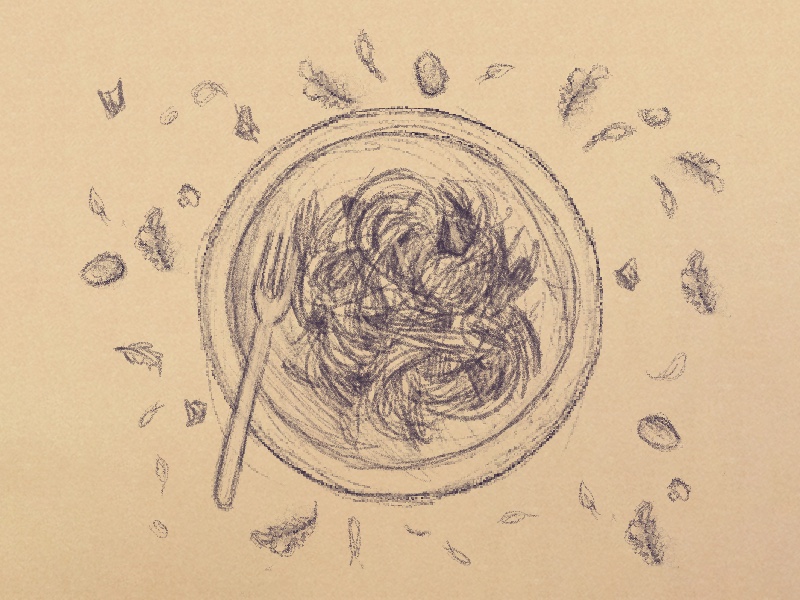By: Arlette Martinez
During his presentation, “The Invention of Authentic Food: Constructing Traditionality Through Ingredients and Matters,” at the 2021 Food Matters and Materialities Conference, Alessandro Gerosa questioned the concept of ‘authenticity’ and its importance in contemporary food cultures. A postdoctoral researcher in Economic Sociology at the Catholic University of Milan, Gerosa conducted semi-structured interviews with forty bartenders and street food vendors in Milan, Italy, to discuss what they do, how they do it, and the types of technologies they use.

Credits: Illustration by Kit Chokly.
According to Gerosa, “authenticity” is used so often and for so many different things that its meaning is fluid and can change over time. Gerosa explains that authenticity is a “myth with material qualities when it comes to food.” In other words, a dish contains different components. Over time, the dish’s perceived authenticity will depend on whether or not it includes those components or food products and what type of meaning eaters assign to that dish.
As Gerosa argues, analyzing the interaction between a dish’s material aspects and its meanings helps us critically think of authenticity as a concept. He argues that in a capitalist society, “people think of industrial products as mainstream. Still, so many use the word to create a difference in their products that ‘authenticity’ is the new mainstream. And so here you have these apparent contradictions between the terms.”
Gerosa points out the importance of historical context to understand how “authenticity” has changed. “Society wanted to be technological and look towards the future. So, people looked down on farmers’ traditional products because making them required little technology. But from 1968 and through the 70s, there was a revolt against this idea of industrial production and standardization. And so, the relevance of authenticity in contemporary consumption patterns is a natural and significant outcome of this process.”
Gerosa argues that the idea of authenticity also mythologizes certain products and dishes. We might imagine them as genuine snippets of a place and its culture. He also argues that “authentic products tend to be labour-intensive and require the best possible raw materials.” In addition, Gerosa highlights that certain ingredients are often associated with traditional culinary practices, including, for example, in Italy, which is a source of great pride. In some cases, a product’s authenticity is protected by special labels and laws to ensure they are produced, processed, and prepared in a specific geographical area, using local ingredients and the recognized know-how of local producers.
But authenticity is not a fixed, inherent characteristic of a dish or a product, argues Gerosa. Instead, it’s a fluid, socially constructed concept. Pasta carbonara is a well-known Italian dish and is an excellent example of how authenticity becomes socially constructed. According to Gerosa, there are two dominant theories on the possible origins of carbonara. The first one traces it to shepherds in the Lazio region who had to stay weeks herding their sheep in the mountains. They carried cured meats like guanciale or bacon because they don’t spoil quickly. The shepherds also found raw eggs from the chickens they came across. “You can imagine that it was a very different recipe. It was eggs, bacon and some fat. I don’t know what specific pasta they used. But that’s one, and that’s the most probable origin.”
The second explanation for carbonara’s origin might sound made up, but according to Gerosa, it is plausible. “Carbonara doesn’t appear in Italian recipe books published before WWII; the theory is that authentic carbonara was invented during this time. American forces liberated Rome and stayed for a while following the allied victory. They provided Romans with mostly chocolate, canned bacon, and powdered eggs.”
Gerosa’s points are valid beyond the Italian context. Tacos al pastor are one of Mexico’s most famous tacos, made with marinated pork, cooked on a vertical spit, served with onions, cilantro, and pineapple. This dish dates back to around the 1930s and is the product of Lebanese immigrants’ who, to make a living, used local ingredients and tailored their food to the local’s taste. Think of tacos al pastor as shawarma’s distant-Mexican cousin.
Tempura is another “authentic” dish with vague origins and elements of cultural mixing. It probably originated in the 16th century and is an adaptation of peixinhos da horta – a Portuguese dish of battered and fried green beans deep-fried in oil. Portuguese merchants prepared peixinhos da horta for the Japanese, who then adapted it to their taste.
These examples are just a small glimpse into how complicated and fluid authenticity can be – a socially constructed perception of a dish being attached to a place that sometimes ignores the complex food history and social interactions.
Thank you to Alessandro Gerosa for sharing such a fascinating conversation with me.